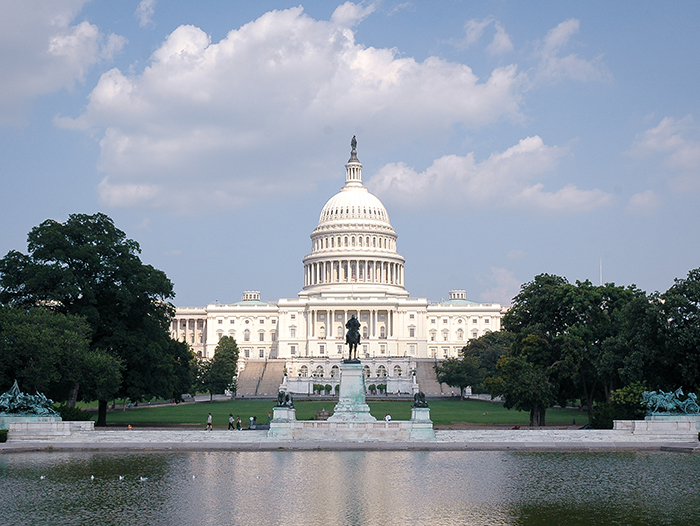House Republicans on Sunday released a budget proposal that would result in large cuts to Medicaid and would include enacting Medicaid work requirements as well as more frequent eligibility checks. Here's what you need to know.
Details on the proposal
Under Congress' budget resolution, which passed in April, the House Energy and Commerce Committee (which has sole jurisdiction over Medicaid and shared jurisdiction over Medicare) was directed to achieve at least $880 billion in reductions to the deficit from 2025 to 2034.
Overall, the House's proposal would reduce federal spending by an estimated $912 billion over the next decade and cause 8.6 million people to become uninsured, according to a partial analysis released by the Congressional Budget Office (CBO). The majority of those cuts ($715 billion) would come from changes to Medicaid and the Affordable Care Act.
Specifically, the proposal increases paperwork requirements across the Medicaid program, allowing states to check the income and residency of beneficiaries more often and permitting states to terminate coverage for those who don't respond promptly.
A CBO analysis of the paperwork change published last week suggested it could lead to 2.3 million people losing Medicaid coverage, many of whom are also enrolled in Medicare but use Medicaid to cover co-payments they can't afford. Since this population is at special risk, CBO found the policy would cause only 600,000 more Americans to lose any form of health insurance. However, it would cause many more to have difficulties paying for medical care.
The proposal also includes a provision that would bar people from using Medicaid unless their citizenship, nationality, or immigration status has been verified.
In addition, the proposal would require states to impose Medicaid work requirements on all "able bodied" Medicaid beneficiaries ages 19 to 64 who do not have dependents. Specifically, it would require such beneficiaries to work, volunteer, or attend school for 80 hours each month, with exceptions for pregnant women, tribal members, and people with serious medical conditions. People would have to verify their eligibility twice a year in order to be in the program.
A CBO report from 2023 found that work requirements for people ages 19 to 55 would save around $109 billion over a decade and lead to 600,000 people becoming uninsured at a minimum. It would also shift $65 billion in costs over to states.
The proposal would also require Medicaid beneficiaries who make more than the federal poverty limit, which is currently around $15,650 for a single person, to pay higher co-payments for their doctor visits. Generally, Medicaid requires limited cost-sharing from its beneficiaries — this proposal would require co-payments of $35 for many medical services, with a cap of 5% of a person's income.
In addition, the proposal makes changes to longstanding rules allowing states to impose so-called "provider taxes" on hospitals, nursing homes, and other providers and to use various accounting maneuvers to utilize those taxes to obtain additional federal funding.
The proposal would freeze all state taxes at their current rates and prevent states from using special related payments to pay hospitals higher prices for Medicaid services than Medicare pays. Currently, every state except for Alaska has a provider tax.
The proposal also reduces federal funding for all childless adults without disabilities from 90% to 80% if the state subsidized coverage for such people. According to the New York Times, this change would mean major funding cuts to states including California, New York, and Washington unless they eliminated their programs that enroll undocumented people into Medicaid. Generally speaking, undocumented immigrants aren't eligible for Medicaid, but some states pay to provide that coverage themselves.
There are also a number of small changes to Medicaid included in the bill, such as one that prevents owners of expensive homes from obtaining nursing home coverage, another that prevents coverage of gender-affirming care for transgender minors, and various provisions aimed at purging Medicaid's rolls of ineligible immigrants and people who have died.
The proposal would also prevent Medicaid from funding healthcare providers who also offer abortion services.
The proposal also includes changes to the enrollment processes for people who purchase their insurance through the Affordable Care Act marketplaces, including shortened enrollment periods, tightened income verification, and restrictions on access for immigrants in the Deferred Action for Childhood Arrivals program.
Reaction from Congress
The Energy and Commerce Committee will meet on Tuesday to consider the legislation, however its political path forward is uncertain. Over a dozen House Republicans have told House Speaker Mike Johnson (R-La.) and other Republican leaders they won't support cuts to healthcare safety net programs their constituents rely on, and President Donald Trump himself has vowed there would be no cuts to Medicaid.
In an op-ed for the New York Times, Sen. Josh Hawley (R-Mo.) also opposed cuts to Medicaid, writing that "It's safe to say the Trump coalition was not pulling the lever for Medicaid cuts in November."
Instead, Hawley wrote that working families deserve a cap on prescription drug prices and tax cuts. "What we should not do is eliminate their healthcare," he wrote.
Advisory Board's HEALTH POLICY resources
- What's happened in Washington (so far) and what policy changes we're bracing for
- Congress is weighing spending cuts. How will they impact healthcare?
- How federalism will shape health policy in 2025
- 2026 CMS Advance Notice Executive Summary
- Your guide to CMS' 14 value-based payment models
- How federal cost control tactics promote an enduring hybrid payment environment
Sen. Ron Wyden (D-Ore.), the ranking Democrat on the Senate Finance Committee, also spoke out against the proposal, saying the Republican party has "defied the will of the American public by proposing the largest Medicaid cut in history."
"In no uncertain terms, millions of Americans will lose their health care coverage, hospitals will close, seniors will not be able to access the care they need, and premiums will rise for millions of people if this bill passes," said Rep. Frank Pallone (D-N.J.), the top Democrat on the Energy and Commerce Committee.
In an op-ed for the Wall Street Journal, Rep. Brett Guthrie (R-Ky.), chair of the Energy and Commerce Committee, defended the Medicaid work requirement proposal, saying that Congress "can't afford to undermine [Medicaid] further by subsidizing capable adults who choose not to work."
Guthrie added that while "Democrats will use this as an opportunity to engage in fear-mongering and misrepresent our bill as an attack on Medicaid," the bill "preserves and strengthens Medicaid for children, mothers, people with disabilities and the elderly — for whom the program was designed."
The potential impact on providers
Experts say that limiting the flow of Medicaid dollars to states would have a significant impact on providers, especially those that serve higher numbers of low-income people, hospitals in rural communities, and long-term care providers who already heavily rely on the program.
Ngozi Ezike, president and CEO of Sinai Chicago, said the health system has built contingency plans to make sure that it can sustain its operations, which could include service cuts.
"We understand that we might have to provide less care — to cut and minimize our losses — rather than continue to try to do everything and not be able to provide anything in the long run," Ezike said.
Edwin Park, a research professor at the Georgetown University McCourt School of Public Policy, noted that states are required to balance their budgets, meaning that they will have to raise taxes, cut other parts of their budgets, or cut Medicaid, which could include reducing provider rates, limiting eligibility, or cutting benefits.
The size of any potential cuts would have significant consequences for providers, according to Alice Burns, associate director with KFF's program on Medicaid and the uninsured.
According to an analysis by KFF, operating margins were 1.7% and 2.3%, respectively, for hospitals with high shares of Medicaid patients in rural and urban areas. Meanwhile in 2023, operating margins across all hospitals was 5.2%.
After the COVID-19 pandemic, many hospitals were already looking to find efficiencies and reduce expenses, according to Mary Haddad, president and CEO of the Catholic Health Association.
"We recognize the fact that we have finite resources, and we're going to have to figure out how we're going to continue to provide care for those most in need," she said. "It will have a drastic impact."
Smaller safety-net hospitals could also close their doors if there are Medicaid cuts, Ezike noted.
"That would continue this spiral of having people not access care and then present much later with much more advanced disease, resulting in much worse outcomes," she said. "That life expectancy gap that we're actively working to narrow will actually have the possibility of getting worse."
(Sanger-Katz/Edmondson, New York Times, 5/12; Wilkerson, STAT+ [subscription required], 5/12; Mascaro, Associated Press, 5/12; Beggin, USA Today, 5/12; Weixel, The Hill, 5/11; Olsen, Healthcare Dive, 5/9)
Don't miss out on the latest Advisory Board insights
Create your free account to access 1 resource, including the latest research and webinars.
Want access without creating an account?
You have 1 free members-only resource remaining this month.
1 free members-only resources remaining
1 free members-only resources remaining
You've reached your limit of free insights
Become a member to access all of Advisory Board's resources, events, and experts
Never miss out on the latest innovative health care content tailored to you.
Benefits include:
You've reached your limit of free insights
Become a member to access all of Advisory Board's resources, events, and experts
Never miss out on the latest innovative health care content tailored to you.
Benefits include:
This content is available through your Curated Research partnership with Advisory Board. Click on ‘view this resource’ to read the full piece
Email ask@advisory.com to learn more
Click on ‘Become a Member’ to learn about the benefits of a Full-Access partnership with Advisory Board
Never miss out on the latest innovative health care content tailored to you.
Benefits Include:
This is for members only. Learn more.
Click on ‘Become a Member’ to learn about the benefits of a Full-Access partnership with Advisory Board
Never miss out on the latest innovative health care content tailored to you.


